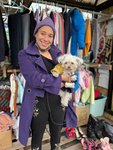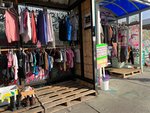






Sometimes a revolutionary act is quiet, unseen. Sometimes it’s loud and worn on a shirtsleeve. At The People’s Closet at George Floyd Square, it’s a little bit of both.
Born out of the 2020 Uprising, The People’s Closet sprang from a need for clothing as well as a need to organize an outpour of donations. The closet grew organically, ultimately using resources that became available during a time of upheaval and transformation – bus shelters for a transit route on hiatus as people filled the streets to mourn, pray and stand in solidarity. Now, some 18 months after the murder that took place at this intersection shook the world, neighbors still stop by daily to see if there’s something they can take to a friend or their own closet.
It is yet another example of mutual aid rising out of the movement for racial justice – and the staying power of giving as folks continue to wade through COVID-19 and economic disparities. Clothing is donated and taken freely, without obligation. There are no transactions, and it’s always open.
“It’s all about helping people. Clothes are a necessity,” said Jennie Leenay, who is one of at least a dozen GFS community members who care for the clothing and space, tidying it up, making sure items are accessible – or covering them up when it rains. “The people in this neighborhood have been immensely helpful. They love this closet, and they prove it with how much they help to maintain it.”
In addition to being a resource for neighbors, The People’s Closet also works with certain encampment groups, ensuring they have the right gear for the weather. As winter approaches and cold temperatures roll in, keeping people warm and preventing hypothermia is a matter of public safety.
Needs aside, fashion is also a presentation of self. And to that end, the closet’s caretakers follow what they call the “no dignity” rule, discarding items that are just too tattered to pass along.
“If I personally wouldn’t feel comfortable wearing that out in society in public, I wouldn’t put it here for somebody else to wear. This isn’t about charity, it’s about mutual aid,” said Leenay. “It’s about ‘Hey, I have this cool jacket that I just don’t wear any more, someone can have use of it,’ and it doesn’t have to be about selling it or trying to make a profit. Not everything has to be for profit or monetizing something. Sometimes it’s just like, ‘Hey, I saw you needed this. Here it is.’”
A natural fit
For Leenay, a fashion designer with an associate degree in apparel technologies, caring for The People’s Closet was a natural fit. Leenay lives near GFS, and like many, first came to 38th and Chicago to join protests after seeing the video of Minneapolis Police officers killing George Floyd.
“There was nowhere else in the world I really felt I should be,” they said. They helped where they could – with the firekeepers, cleaning up, going to meetings, being in community, and “Bein’ Black and takin’ space.” Among other donations, clothes kept coming in, and eventually community members decided to begin hanging stuff up so people could have it.
“It [was] also in the midst of a pandemic, a lot of people [were] out of work. The whole world was just turned on its head with the uprising and everything, and we all were just like ‘How are we gonna come together and heal?’” Leenay recalled. What eventually came to be known as The People’s Closet was a way to provide, and as some community members got involved in other work, Leenay began taking the lead in its care.
“I was like, I have a fashion background, I’m a fashion student, I know how to handle clothes. I know what needs to be maintained, what can be washed out, what can’t be washed out –and so I started helping out more when they were having big asks,” they said. “As we say here, ‘Bring your gift to the Square,’ and this was the gift I had.”
Fashion as political statement
Leenay describes her personal design style as afrofuturistic, inspired by the idea of taking Black culture and pushing it towards the future. Afrofuturism arose in the 1990s as a response, in part, to the exclusion of Black authors and Black stories in the science fiction world.
“[It gave the] impression that they don’t really see Black people in the future,” said Leenay. “We’re all like… uh uh. No. We gonna be there. And our skin will be glowing.” She wore one of her outfits at a fashion show held on Chicago Ave. in September.
With an eye to the future, Leenay is also honoring tradition. Her great-grandfather was a tailor, and her grandmother instilled in her the importance of maintaining clothes. In these days of “fast fashion” – mass producing the hot new trend then moving on to the next thing – this has become a lost art.
“Fashion is something that should be passed down, and we notice that from a lot of our cultures is that’s something the Black community kind of lost through the struggle, through the African slave trade,” said Leenay, quickly correcting: “British slave trade, realistically speaking.”
She wants her fashion to honor and uplift the Black community, especially Black women, in a very politically charged fashion.
Fashion as communal act
It’s also important to Leenay that fashion reaches everyday people – not just the rich and famous – and that people feel connected to themselves and their community. It was a community member who gave them the boots and jacket Leenay wears, and it’s great to return the gesture – setting aside a shirt they know a specific someone will love.
“It becomes this very communal sense of understanding a person and understanding of how they wish to be seen and how they identify,” said Leenay. They’ve received a lot of donations from people in transition, for example, who are trying to get rid of all these clothes that no longer fit with their gender identity, and Leenay is happy to help. Sometimes it’s as simple as knowing someone’s favorite color, like the yellow fabric sewn into another community member’s birthday dress.
“The people I’ve spent a year and a half getting to know, I live next to them, I talk to them pretty much every single day. And there’s just something very… fashion should be communal. It’s a communal act.”
The People’s Closet embodies all of the above – the political and the communal, the reason for its existence in full view. The shelters themselves wear it every day as body art – sentiments from the Uprising spray painted on their windowed walls: No justice No [peace symbol]; White Silence is Violence; Floyd Square; We Have Power. They are accessorized by the rods and hangers holding clothing, the cabinet with a drawer marked “undies,” benches lined with shoes, a wooden pallet to lift cardboard boxes off the ground. A flyer affixed to an outside wall reads in faded ink, “This space matters. And the people who work here. And their families.” Taped to an inside wall positioned just above a rack of children’s clothes is another that reads, “Justice does not rain down from heaven. We must build it brick by brick. Let’s get to work!”
These sentiments form the threads which bind the GFS community and continued calls for justice.
“This space was built out of pain and grief, and it has become something beautiful. But let’s not forget that we’re out here because a man was summarily executed by… police, and they wanted to brush it under the rug,” said Leenay. “It’s through the act of us coming together and protesting, not [letting up], bein’ here for 18 months, is how we got the first ever [White] officer in the state convicted and actually sent to jail.”
The work isn’t done, added Leenay, who listed off other injustices: the three officers charged with aiding and abetting Derek Chauvin in George Floyd’s murder; the murders of Winston Smith and Daunte Wright; the lack of investigation into Murphy Ranks’ killer.
“We’re here fighting for Black and Indigenous lives on stolen Indigenous land. We’ve done a lot, and it’s amazing what we’ve done to join and heal together, but the work isn’t done yet,” they said, inviting people to stop by. “Come on through… we’re here fighting just to say, ‘Hey, my life matters. Black lives matter…’ Read the 24 demands. No Justice, No Streets. And we meant that.”
Comments
No comments on this item Please log in to comment by clicking here